Resource(s) available in Nicaragua Revolution: David Schwartz Collection's collection
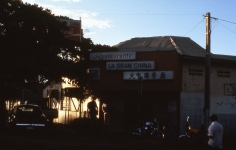
Restaurante La Bran China
Restaurante La Bran China in Nicaragua. Archived by Leah Williams. Photographed by Professor David Schwartz, Albright College, n.d.
David Schwartz Collection, Albright College

Rigoberto López Pérez Portrait
Portrait of Rigoberto López Pérez, Nicaraguan revolutionary leader who assassinated President Anastasio "Tacho" Somoza García. Red and black are used to represent the colors of the FSLN flag. Archived by Leah Williams. Photographed by Professor David Schwartz, Albright College, 1984.
David Schwartz Collection, Albright College

Rigoberto López Pérez Portrait
Portrait of Rigoberto López Pérez, Nicaraguan revolutionary leader who assassinated President Anastasio "Tacho" Somoza García. The text reads: "Lo mio no ha sido un sacrificio. Sino un deber que espero haber cumplido" ~Rigoberto López Pérez, heroe nacional. The English translation is "Mine has not been a sacrifice. But a duty that I hope to have fulfilled." Red and black are used to represent the colors of the FSLN flag. Archived by Leah Williams. Photographed by Professor David Schwartz, Albright College, 1984.
David Schwartz Collection, Albright College
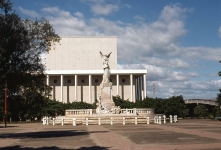
Rubén Darío Monument
Pictured is the Rubén Darío monument, still located in Managua, Nicaragua near the Plaza de la revolución. Rubén Darío was a famous Nicaraguan poet who spurred modernism, a 19th century literary movement. Although he passed away in 1916, the statue contains the year 1933. This is because the monument was recently refurbished after the original 1933 statue. Archived by Leah Williams. Photographed by David Schwartz, Albright College, 1981.
David Schwartz Collection, Albright College
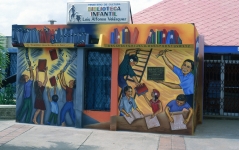
The Children are the Garden of the Revolution: Biblioteca Infantil (1/4)
The children are the garden of the revolution, which was painted in the children's library of Luis Alfonso Velásquez, is related to the literacy movement in Nicaragua. The mural was completed in 1984 by North American artists in solidarity with Nicaraguans and was destroyed in 1992. This colorful mural has many images of children, and there are building blocks with Spanish words such as "esperanza" (hope), "amistad" (friendship), "alegría" (happiness), "justicia" (justice), "paz" (peace), "unidad" (unity), "amor" (love), "sobriedad" (sobriety), and "dignidad" (dignity). These values show the hope for a future better than the present situation of Nicaragua. The mural emphasizes diversity and a large map with the words "declaración de solidaridad internacional" (declaration of international solidarity) symbolizes a connection with the rest of the world. On one side of the mural is a woman with a weapon embracing two children and on the other side of the library. On the other side of the library is a painting of Augusto Sandino, hence the iconic sombrero, with a baby in his arms. Archived by Leah Williams. Photographed by David Schwartz, Albright College, 1984.
David Schwartz Collection, Albright College
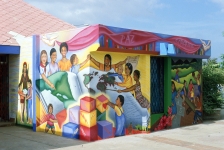
The Children are the Garden of the Revolution: Biblioteca Infantil (2/4)
The children are the garden of the revolution, which was painted in the children's library of Luis Alfonso Velásquez, is related to the literacy movement in Nicaragua. The mural was completed in 1984 by North American artists in solidarity with Nicaraguans and was destroyed in 1992. This colorful mural has many images of children, and there are building blocks with Spanish words such as "esperanza" (hope), "amistad" (friendship), "alegría" (happiness), "justicia" (justice), "paz" (peace), "unidad" (unity), "amor" (love), "sobriedad" (sobriety), and "dignidad" (dignity). These values show the hope for a future better than the present situation of Nicaragua. The mural emphasizes diversity and a large map with the words "declaración de solidaridad internacional" (declaration of international solidarity) symbolizes a connection with the rest of the world. On one side of the mural is a woman with a weapon embracing two children and on the other side of the library. On the other side of the library is a painting of Augusto Sandino, hence the iconic sombrero, with a baby in his arms. Archived by Leah Williams. Photographed by David Schwartz, Albright College, 1984.
David Schwartz Collection, Albright College

The Children are the Garden of the Revolution: Biblioteca Infantil (3/4)
The children are the garden of the revolution, which was painted in the children's library of Luis Alfonso Velásquez, is related to the literacy movement in Nicaragua. The mural was completed in 1984 by North American artists in solidarity with Nicaraguans and was destroyed in 1992. This colorful mural has many images of children, and there are building blocks with Spanish words such as "esperanza" (hope), "amistad" (friendship), "alegría" (happiness), "justicia" (justice), "paz" (peace), "unidad" (unity), "amor" (love), "sobriedad" (sobriety), and "dignidad" (dignity). These values show the hope for a future better than the present situation of Nicaragua. The mural emphasizes diversity and a large map with the words "declaración de solidaridad internacional" (declaration of international solidarity) symbolizes a connection with the rest of the world. On one side of the mural is a woman with a weapon embracing two children and on the other side of the library. On the other side of the library is a painting of Augusto Sandino, hence the iconic sombrero, with a baby in his arms. Archived by Leah Williams. Photographed by David Schwartz, Albright College, 1984.
David Schwartz Collection, Albright College

The Children are the Garden of the Revolution: Biblioteca Infantil (4/4)
The children are the garden of the revolution, which was painted in the children's library of Luis Alfonso Velásquez, is related to the literacy movement in Nicaragua. The mural was completed in 1984 by North American artists in solidarity with Nicaraguans and was destroyed in 1992. This colorful mural has many images of children, and there are building blocks with Spanish words such as "esperanza" (hope), "amistad" (friendship), "alegría" (happiness), "justicia" (justice), "paz" (peace), "unidad" (unity), "amor" (love), "sobriedad" (sobriety), and "dignidad" (dignity). These values show the hope for a future better than the present situation of Nicaragua. The mural emphasizes diversity and a large map with the words "declaración de solidaridad internacional" (declaration of international solidarity) symbolizes a connection with the rest of the world. On one side of the mural is a woman with a weapon embracing two children and on the other side of the library. On the other side of the library is a painting of Augusto Sandino, hence the iconic sombrero, with a baby in his arms. Archived by Leah Williams. Photographed by David Schwartz, Albright College, 1984.
David Schwartz Collection, Albright College
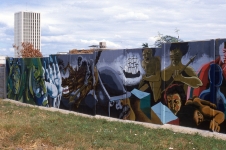
The Supreme Dream of Bolívar (1/8)
Completed in 1983, The Supreme Dream of Bolívar was located on la avenida Bolívar, Managua. Unfortunately, the majority of this mural was destroyed on October 25, 1990, after the Sandinistas lost the elections, and the rest of the mural was destroyed in 1991. Both artists of this mural, Víctor Canifrú and Alejandra Acuña Moya, were Chilean exiles. The mural was painted 200 years after the death of Simón Bolívar, who was a symbol of independence for many Latin American countries. There are many segments of the mural, and there are not many photographs of the mural, especially of the entire mural. One segment of the mural depicts the United States as a grim reaper, as the U.S., Spain, and Christianity were used as tools of cultural oppression in Latin American countries such as Nicaragua. Archived by Leah Williams. Photographed by David Schwartz, Albright College, 1984.
David Schwartz Collection, Albright College
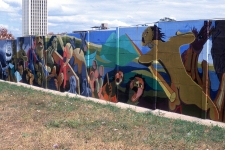
The Supreme Dream of Bolívar (2/8)
Completed in 1983, The Supreme Dream of Bolívar was located on la avenida Bolívar, Managua. Unfortunately, the majority of this mural was destroyed on October 25, 1990, after the Sandinistas lost the elections, and the rest of the mural was destroyed in 1991. Both artists of this mural, Víctor Canifrú and Alejandra Acuña Moya, were Chilean exiles. The mural was painted 200 years after the death of Simón Bolívar, who was a symbol of independence for many Latin American countries. There are many segments of the mural, and there are not many photographs of the mural, especially of the entire mural. One segment of the mural depicts the United States as a grim reaper, as the U.S., Spain, and Christianity were used as tools of cultural oppression in Latin American countries such as Nicaragua. Archived by Leah Williams. Photographed by David Schwartz, Albright College, 1984.
David Schwartz Collection, Albright College
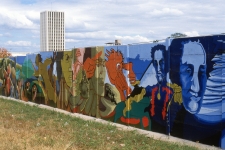
The Supreme Dream of Bolívar (3/8)
Completed in 1983, The Supreme Dream of Bolívar was located on la avenida Bolívar, Managua. Unfortunately, the majority of this mural was destroyed on October 25, 1990, after the Sandinistas lost the elections, and the rest of the mural was destroyed in 1991. Both artists of this mural, Víctor Canifrú and Alejandra Acuña Moya, were Chilean exiles. The mural was painted 200 years after the death of Simón Bolívar, who was a symbol of independence for many Latin American countries. There are many segments of the mural, and there are not many photographs of the mural, especially of the entire mural. One segment of the mural depicts the United States as a grim reaper, as the U.S., Spain, and Christianity were used as tools of cultural oppression in Latin American countries such as Nicaragua. Archived by Leah Williams. Photographed by David Schwartz, Albright College, 1984.
David Schwartz Collection, Albright College
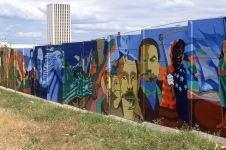
The Supreme Dream of Bolívar (4/8)
Completed in 1983, The Supreme Dream of Bolívar was located on la avenida Bolívar, Managua. Unfortunately, the majority of this mural was destroyed on October 25, 1990, after the Sandinistas lost the elections, and the rest of the mural was destroyed in 1991. Both artists of this mural, Víctor Canifrú and Alejandra Acuña Moya, were Chilean exiles. The mural was painted 200 years after the death of Simón Bolívar, who was a symbol of independence for many Latin American countries. There are many segments of the mural, and there are not many photographs of the mural, especially of the entire mural. One segment of the mural depicts the United States as a grim reaper, as the U.S., Spain, and Christianity were used as tools of cultural oppression in Latin American countries such as Nicaragua. Archived by Leah Williams. Photographed by David Schwartz, Albright College, 1984.
David Schwartz Collection, Albright College
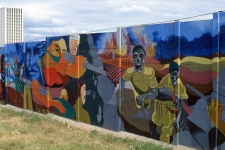
The Supreme Dream of Bolívar (5/8)
Completed in 1983, The Supreme Dream of Bolívar was located on la avenida Bolívar, Managua. Unfortunately, the majority of this mural was destroyed on October 25, 1990, after the Sandinistas lost the elections, and the rest of the mural was destroyed in 1991. Both artists of this mural, Víctor Canifrú and Alejandra Acuña Moya, were Chilean exiles. The mural was painted 200 years after the death of Simón Bolívar, who was a symbol of independence for many Latin American countries. There are many segments of the mural, and there are not many photographs of the mural, especially of the entire mural. One segment of the mural depicts the United States as a grim reaper, as the U.S., Spain, and Christianity were used as tools of cultural oppression in Latin American countries such as Nicaragua. Archived by Leah Williams. Photographed by David Schwartz, Albright College, 1984.
David Schwartz Collection, Albright College
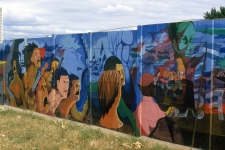
The Supreme Dream of Bolívar (6/8)
Completed in 1983, The Supreme Dream of Bolívar was located on la avenida Bolívar, Managua. Unfortunately, the majority of this mural was destroyed on October 25, 1990, after the Sandinistas lost the elections, and the rest of the mural was destroyed in 1991. Both artists of this mural, Víctor Canifrú and Alejandra Acuña Moya, were Chilean exiles. The mural was painted 200 years after the death of Simón Bolívar, who was a symbol of independence for many Latin American countries. There are many segments of the mural, and there are not many photographs of the mural, especially of the entire mural. One segment of the mural depicts the United States as a grim reaper, as the U.S., Spain, and Christianity were used as tools of cultural oppression in Latin American countries such as Nicaragua. Archived by Leah Williams. Photographed by David Schwartz, Albright College, 1984.
David Schwartz Collection, Albright College
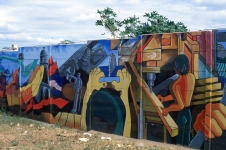
The Supreme Dream of Bolívar (7/8)
Completed in 1983, The Supreme Dream of Bolívar was located on la avenida Bolívar, Managua. Unfortunately, the majority of this mural was destroyed on October 25, 1990, after the Sandinistas lost the elections, and the rest of the mural was destroyed in 1991. Both artists of this mural, Víctor Canifrú and Alejandra Acuña Moya, were Chilean exiles. The mural was painted 200 years after the death of Simón Bolívar, who was a symbol of independence for many Latin American countries. There are many segments of the mural, and there are not many photographs of the mural, especially of the entire mural. One segment of the mural depicts the United States as a grim reaper, as the U.S., Spain, and Christianity were used as tools of cultural oppression in Latin American countries such as Nicaragua. Archived by Leah Williams. Photographed by David Schwartz, Albright College, 1984.
David Schwartz Collection, Albright College
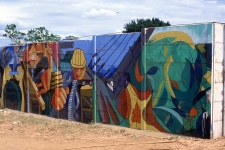
The Supreme Dream of Bolívar (8/8)
Completed in 1983, The Supreme Dream of Bolívar was located on la avenida Bolívar, Managua. Unfortunately, the majority of this mural was destroyed on October 25, 1990, after the Sandinistas lost the elections, and the rest of the mural was destroyed in 1991. Both artists of this mural, Víctor Canifrú and Alejandra Acuña Moya, were Chilean exiles. The mural was painted 200 years after the death of Simón Bolívar, who was a symbol of independence for many Latin American countries. There are many segments of the mural, and there are not many photographs of the mural, especially of the entire mural. One segment of the mural depicts the United States as a grim reaper, as the U.S., Spain, and Christianity were used as tools of cultural oppression in Latin American countries such as Nicaragua. Archived by Leah Williams. Photographed by David Schwartz, Albright College, 1984.
David Schwartz Collection, Albright College
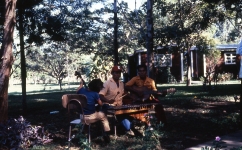
Three Men Playing Guitars and Xylophone
Three men are outside playing guitars and an xylophone or marimba. Archived by Leah Williams. Photographed by David Schwartz, Albright College, 1981.
David Schwartz Collection, Albright College
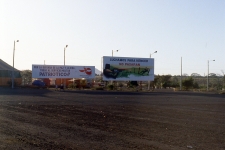
Two Political Billboards
Two billboards are pictured. The billboard to the left, backed by the "Comite Nicaraguense por la paz," reads: "Por la defensa de la paz y la vida, todos al servicio military patriotico!!!" The English translation is "For the defense of peace and life, all to the patriotic military service!!!" The billboard to the right reads: "Luchamos para vencer no pasaran," or in English, "We fight to overcome, they will not pass." Archived by Leah Williams. Photographed by David Schwartz, Albright College, 1984.
David Schwartz Collection, Albright College
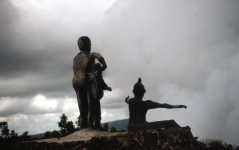
Unidentified Statues
Pictured is a group of unidentified statues, which appear Mayan-like. Archived by Leah Williams. Photographed by David Schwartz, Albright College, 1984.
David Schwartz Collection, Albright College
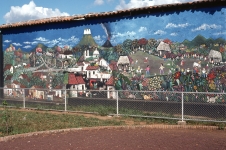
Village Life (1/2)
Village Life was located on the other side of El Encuentro in Luis Alfonso Velásquez Park. The mural was painted by three different artists, including Manuel García, Hilda Vogle and Julie Aguirre in 1980 and was destroyed by the government in 1990. With bright, optimistic colors, the mural reinforces hope for a better future. The mural, an example of the primitivism style, shows details of peasant life in the village, but the painted image is not the reality of people living in poverty in Nicaragua, especially during the revolution. In addition, the mural contrasts the country versus city life. The mural shows a great deal of flowers, animals, houses, children playing and evidence of a colorful life. In addition, there FSLN flags pictured that emphasize support for the Sandinistas. A street in the mural shows demonstrations in favor of the literacy campaign. For example, three men in the mural have a poster that reads "Alfabetización es liberación," or in English, "Literacy is freedom." Although this colorful life is unrealistic for peasants, the mural captures the spirit of the people during a period of revolution. Archived by Leah Williams. Photographed by David Schwartz, Albright College, 1981.
David Schwartz Collection, Albright College
